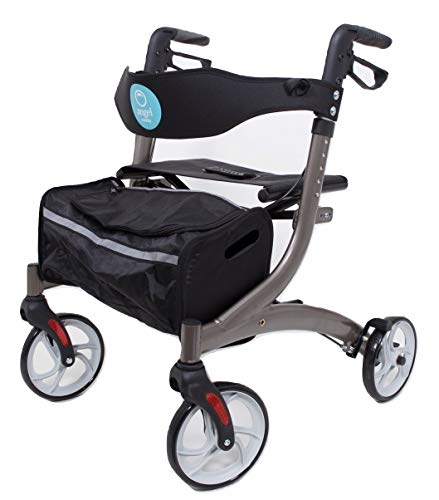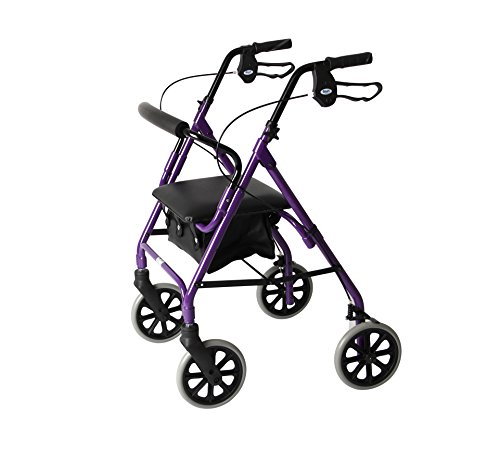
Walkers With Seats
The seats on Walkers allow users to maintain a normal walk, reducing back pain as well as other wrist or hand injuries. They also aid in independence by allowing for continued movement.
Aluminum frames are used to create lightweight walking aids that can be adjusted and repositioned with seats. The padded seat permits the user to rest when needed.
Folding
For individuals who require extra stability while walking, a folding seat walker is a great choice. These aids to mobility permit users to take a seated break anytime, providing safety and comfort for longer journeys or excursions. These aids for mobility are easy to move and have built-in storage, such as bags or baskets under the fold-up seat. You can also buy various accessories to match your model, such as storage bags and trays.
The grips for the handle on the sides of a seat walker or
rollator walker with seat uk are typically constructed of plastic, foam or gel. If the grips aren't comfortable, the user can replace them with grips that provide a better fit for their hand size. If your hands sweat a lot, or you suffer from arthritis or any other gripping issue, then larger grips may be better.
Three-wheeled walkers are less stable than four-wheel models, but they are more manageable and easier to navigate in tight spaces. They are also lighter and fold to smaller dimensions which makes them ideal for travel or storage in small homes and apartments. Some three-wheeled models even have a seat that can be folded down, which can fold up when not in use to conserve space.
The EZ Fold N Go rollator provides the advantages of a traditional walker that has a seat but folds 3 times smaller than other rollators. It can be transported by car or bus. It is the perfect option for those who need a walker that has a seat but have a limited space and frequently need to transport. It is light, and comes with a storage bag and a front pouch.
Four-Wheel
Four-wheel walkers that have seats are ideal for those who want to take longer walks outdoors or require more support than the standard rollator. These types of walkers are great for those who suffer from back and hip pain, as they maintain posture and take the weight off their knees. Many come with storage baskets or pouches to carry personal items. Some chairs are padded to provide users with greater comfort, particularly on long journeys. Some have adjustable handles that make it possible to tailor the fit. Some have even an lower spine support backrest.
Look for models with bigger wheels (8" or more in diameter) which can handle uneven surfaces, like gravel. Some models come with an adjustable lever known as"curb climber" that allows the "curb climber" to lift the front wheels above obstacles such as curbs. A smaller set of wheels is better for indoor use as it allows you to move through narrow corridors and through doors.
Handle grips should be comfortable and user-friendly especially for those who suffer from arthritis or sore hands. Some come with soft or gel grips, which are good for people with arthritis. The handle height should also be adjustable to allow for an individual fit. Some models have brake mechanisms that lock into place when brakes are applied. This can be useful for those who accidentally activate the brakes as they move around.
If you're looking for a walker with a seat, select one that has one or offers an accessory holder separate for adding seats. A padded
Seat Walkers & Rollators will make the user more comfortable while they're taking breaks, and some walker-seat combos have a backrest that helps support the spine and keeps the spine in a straight position.
Push-Down Brakes
You can turn on the brakes operated by hand on rollators and walkers by pressing down on the brake levers. These levers can appear like loops or bicycle-style brakes that are integrated into the handles.
They can be locked the same way as you would the brake on bicycles but pressing harder. This provides you with more security when you stand stationary or rest on the seat.
Certain manufacturers offer brakes that can be activated by pushing down the pedal. This makes it easier to use for those who are petite or suffer from arthritis or other gripping problems. They are also a good option for those living in areas that are hilly, and where the additional downward force on the wheels can make it difficult to stop or slow down the walker.
All walker brakes require regular tightening to help them keep their effectiveness and reduce the chance of causing damage. It's simple to perform, and typically involves finding the adjustment screw for the cable that is located close to the brakes. Using the right tool (which differs from model to model) then you'll turn it clockwise until it's secure enough for secure and reliable operation.
Some models on this page include locking brakes that you can activate by pressing down on the levers for brakes by using either or both hands. These are great for those who wish to stay upright, but also need to take a break and sit on a seat. The brakes allow you to keep the walker steady on uneven or rough terrain, and aiding you in maneuvering tight spaces and make sharp turns. It is important to spot signs that the brakes on your walker need to be adjusted, like when it rolls unexpectedly or doesn't stop immediately after you engage the brakes.
Slow-Down Brakes
A braking system that slows down is a unique feature of a rollator. It lets the user control a wheel's maximum speed so that it doesn't accidentally accelerate and move away from the walker. This improves safety, especially when the user is walking down a slope or over rough terrain. It's also a helpful feature for users with one side of their body that is more powerful than the other, since it helps even out the direction of the travel.
These braking systems are typically easy to operate even for people with weak hand strength. They rely on a simple push/pull lever to engage and release. Some slow down brakes have several settings to alter the level of resistance. This allows the walker to be used in a range of conditions and terrain types.
If you're looking for a hands-free solution, you might want to consider one that has seating. This will give you a place to sit down for longer trips as well as provide the walker additional stability while using. Some models of walker include an e-table that can be used to store items like medication or food.
Another type of walker that's ideal for those who can maintain balance but need assistance with their stability or endurance is a hybrid rolling walker. This mobility aid blends design elements from traditional walkers, and rollators. It also comes with a seat, and adjustable height handles. Some hybrid rolling walkers are designed to be heavy-duty, so that they can handle heavier loads. You can find a wide range of hybrid walking walkers on our website. Certain hybrid walkers come with a variety of accessories such as baskets or tray attachments that can help you carry your items.
Seat
Walkers with seats are a great option by individuals who require stability when walking for longer distances or require a break while walking. They can aid those who have reduced weight bearing, neurological conditions such as Parkinson's disease and stroke or general dizziness. Walkers with seats are usually able to be fitted with convenient accessories like baskets, storage options, bags to carry items and oxygen tank holders, as well as forward-facing lights to aid users in dark areas.
rollators walkers with seat are easy to use both indoors and outdoors. They have swivel-wheels that allow them to turn quickly. They are usually lightweight and adjustable in the height to be used by people of all sizes. They can also be fitted with useful accessories, such as baskets and bags to store belongings. They can also be equipped with oxygen tank holders, I.V. poles, and so on. Hand brakes are also available that allow users to stop and slow down their rollator, preventing it from slipping away.

There are three-wheel models as well which are smaller, lighter and can be tucked away in tighter spaces. They are easier to maneuver but don't provide as much stability. They may not be suitable for people who require a lot of weight on the device to support themselves. All rollators have hand brakes, allowing them to be stopped or slowed at any time by squeezing the handles. They can also be set to "park" brake which allows the brakes to remain on for an indefinite period of time. Certain models come with grips that can be replaced with soft ones for greater comfort, specifically those that are used by those who have hands that tend to sweat.

 Walkers With Seats
Walkers With Seats There are three-wheel models as well which are smaller, lighter and can be tucked away in tighter spaces. They are easier to maneuver but don't provide as much stability. They may not be suitable for people who require a lot of weight on the device to support themselves. All rollators have hand brakes, allowing them to be stopped or slowed at any time by squeezing the handles. They can also be set to "park" brake which allows the brakes to remain on for an indefinite period of time. Certain models come with grips that can be replaced with soft ones for greater comfort, specifically those that are used by those who have hands that tend to sweat.
There are three-wheel models as well which are smaller, lighter and can be tucked away in tighter spaces. They are easier to maneuver but don't provide as much stability. They may not be suitable for people who require a lot of weight on the device to support themselves. All rollators have hand brakes, allowing them to be stopped or slowed at any time by squeezing the handles. They can also be set to "park" brake which allows the brakes to remain on for an indefinite period of time. Certain models come with grips that can be replaced with soft ones for greater comfort, specifically those that are used by those who have hands that tend to sweat.